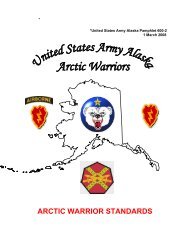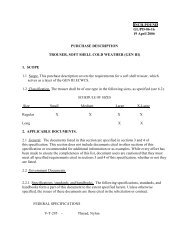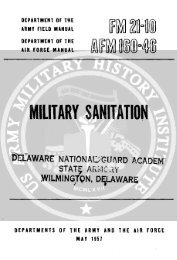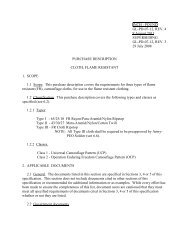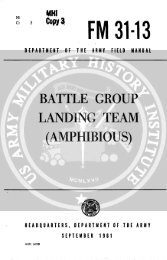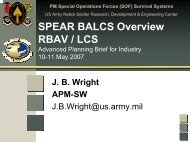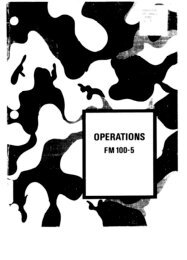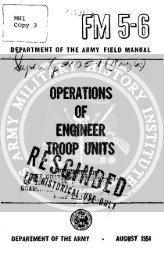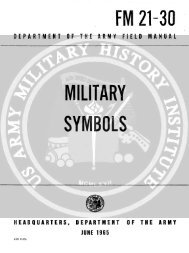DLA Logistics Information Service - CIE Hub
DLA Logistics Information Service - CIE Hub
DLA Logistics Information Service - CIE Hub
Create successful ePaper yourself
Turn your PDF publications into a flip-book with our unique Google optimized e-Paper software.
the<br />
national<br />
stock<br />
number<br />
the gear<br />
that keeps<br />
the supply<br />
chain<br />
running
<strong>DLA</strong> <strong>Logistics</strong><br />
<strong>Information</strong> <strong>Service</strong><br />
Providing Support for All<br />
the Military <strong>Service</strong>s
What is a National Stock Number (NSN)?<br />
A National Stock Number is simply the official label applied to an item of<br />
supply that is repeatedly procured, stocked, stored, issued, and used<br />
throughout the federal supply system. It is a unique item identifying<br />
series of numbers. When a NSN is assigned to an item of supply, data is<br />
assembled to describe the item. Some data elements include<br />
information such as an item name, manufacturer's part number, unit<br />
price, and physical and performance characteristics. NSNs are an<br />
essential part of the military's logistics supply chain used in managing,<br />
moving, storing, and disposing of material.<br />
NSNs are used to identify and manage nearly every imaginable item,<br />
from aircraft parts to light bulbs. The use of NSNs facilitates the<br />
standardization of item names, supply language, characteristics and<br />
management data and aids in reducing duplicate items in the federal<br />
inventory. It also helps to standardize the military requirements for testing<br />
and evaluation of potential items of supply, as well as identifying potential<br />
duplicate items.<br />
The United States Air Force's F/A-22 Raptor.<br />
Thousands of Raptor parts are assigned NSNs.<br />
Many types of commercially made<br />
light bulbs are assigned NSNs<br />
The NSN is officially recognized by the United States government, the<br />
North Atlantic Treaty Organization (NATO), and many governments<br />
around the world. Federal Agencies, including the Department of<br />
Defense (DOD), use the NSN to buy and manage billions of dollars worth<br />
of supplies yearly. Currently, there are over 6 million NSNs in the federal<br />
supply system.<br />
1
Why Was The Concept of a NSN Created?<br />
During World War II, it was common to find different names applied to a<br />
single item of supply used by each military service. That made it difficult<br />
for the military services to locate supplies and, in most cases, impossible<br />
to share items of supply. This resulted in an item depletion situation for<br />
one service and item surplus situation for another due to different<br />
naming conventions.<br />
To illustrate this complex issue, one only needs to consider what the<br />
name of the following item is. Is it a washer, a spacer or a shim?<br />
The correct name for this item is WASHER, FLAT.<br />
This is one example of why it is so important to establish a common<br />
name and description for a single item of supply. If each of the military<br />
services called this washer by a different name, there would be no way<br />
to identify and move assets from one service to another when needed.<br />
Additionally, it was determined to be essential that DOD describe all like<br />
items the same, with the same characteristics to facilitate comparison of<br />
items and avoid proliferation of like items in the DOD inventory.<br />
Even today, commercial entities continue to justify and reinforce the<br />
need for a standardized national stock numbering system.<br />
Manufacturers, as in the case of the preceding washer, use a variety of<br />
item names for identical parts. Cataloging these items with different item<br />
names creates inconsistencies in the various logistics management<br />
systems, making it difficult to identify, separate and control inventory of<br />
items.<br />
Manufacturers use many different commercial part numbering<br />
conventions. For example, manufacturers may refer to their items of<br />
supply using various descriptors like a Universal Product Code (UPC), a<br />
National Drug Code, and/or a Universal Standard Products and <strong>Service</strong>s<br />
Classification Code (UNSPSC) as part of the item description. The NSN<br />
alleviates manufacturers from using various languages to describe items<br />
of supply by standardizing naming conventions and logistics<br />
management data.<br />
2
What Does a NSN Structure Look Like?<br />
Everyone recognizes this number system, (269) 961-7766. It is, of<br />
course, a telephone number. The three distinct parts of a phone number<br />
are easily identifiable. The first part is the area code, the second part is<br />
the exchange, and the third part is a unique four-digit number.<br />
(269) 961-7766 <br />
Just as each part of a telephone number has a distinct meaning, a NSN<br />
is formatted to convey specific information about the item of supply.<br />
The NSN is a 13-digit code, and it is depicted as: 6240-00-357-7976<br />
6240 00 357-7976<br />
Federal<br />
Supply<br />
Class<br />
Country<br />
of<br />
Origin<br />
Unique<br />
Number<br />
The first four digits of the NSN are known as the Federal Supply Class<br />
(FSC). For example, 6240 is the FSC for electric lamps. It is used to<br />
group like items, which would include fluorescent lamps, incandescent<br />
lamps, mercury lamps, and sodium lamps. The next two digits make up<br />
the Country of Origin code. This code signifies the country that originally<br />
requested the NSN assignment. Codes 00 and 01 are both used to<br />
identify the United States. The remaining seven digits are sequentially<br />
assigned and are unique to each NSN.<br />
Who Can Request a NSN Assignment?<br />
Manufacturers and suppliers do not have the authority to request a NSN.<br />
This is usually accomplished once a requirement/need for that<br />
manufacturer's/supplier's item has been identified by a military service,<br />
NATO country, federal/civil agency or various Contractor Support<br />
Weapons Systems (CSWS) managed by a contractor. Requests are<br />
then forwarded thru the appropriate supply chain for cataloging and then<br />
forwarded to <strong>DLA</strong> <strong>Logistics</strong> <strong>Information</strong> <strong>Service</strong> for NSN assignment.<br />
3
Who Assigns a NSN?<br />
The <strong>DLA</strong> <strong>Logistics</strong> <strong>Information</strong> <strong>Service</strong>, located in Battle Creek,<br />
Michigan, assigns all NSNs at the request of the military services, certain<br />
federal and civil agencies, and foreign friendly countries. Each NSN<br />
assigned to an item of supply is the result of a careful review process<br />
known as cataloging. Cataloging is the process whereby each item of<br />
supply is named, assigned a Federal Supply Class, described to identify<br />
all known characteristics and performance data, and ultimately assigned<br />
a NSN. This information is contained and maintained in the Federal<br />
<strong>Logistics</strong> <strong>Information</strong> System (FLIS), which is managed by the <strong>DLA</strong><br />
<strong>Logistics</strong> <strong>Information</strong> <strong>Service</strong>, which is part of the Defense <strong>Logistics</strong><br />
Agency (<strong>DLA</strong>). <strong>DLA</strong> <strong>Logistics</strong> <strong>Information</strong> <strong>Service</strong> is the only<br />
organization authorized to assign NSNs.<br />
Requests for NSNs are initiated whenever a non-stocked item is<br />
repeatedly ordered or when a new weapons system is being developed.<br />
Whenever a new weapon system is deployed by a military service, the<br />
service engages in an upfront review known as a provisioning process.<br />
This process identifies all potential spares to ensure weapon system<br />
support throughout the life cycle of the weapon system. This step is<br />
essential to properly provide support to the warfighter. During the<br />
provisioning process all potential spare parts are identified and requests<br />
for NSN assignment are submitted to <strong>DLA</strong> <strong>Logistics</strong> <strong>Information</strong> <strong>Service</strong>.<br />
NSN: 6240-00-357-7976<br />
Item Name:LAMP, MERCURY VAPOR<br />
Company Name: Westron Corporation<br />
CAGE Code: 51454<br />
4
During NSN assignment, a wide range of logistics data is assembled to<br />
describe the item. This information includes the item name,<br />
manufacturer's part number, unit price, physical and performance<br />
characteristics, shipping data, special handling, storage, shelf life, and<br />
information associated with how to dispose of the item when no longer<br />
needed in the inventory.<br />
Throughout the life of the NSN, this data is routinely updated to include<br />
new manufacturers, price changes, part number changes or other<br />
changes affecting the support, logistics data, or characteristics of the<br />
item.<br />
Who Uses NSNs?<br />
The NSN is used by domestic and foreign governments, all the military<br />
services and various federal and civil agencies. The NSN is officially<br />
recognized by the United States government, the North Atlantic Treaty<br />
Organization (NATO), and many other governments around the world.<br />
The NSN affords the opportunity for greater cross-servicing potential and<br />
facilitates operations that involve many military services from many<br />
nations.<br />
Federal Agencies<br />
Many federal agencies, including the Department of Defense (DOD), use<br />
the NSN to buy and manage billions of dollars worth of supplies yearly.<br />
The Defense <strong>Logistics</strong> Agency (<strong>DLA</strong>) establishes how each <strong>DLA</strong>managed<br />
NSN will be stocked, stored and issued to the military services.<br />
<strong>DLA</strong> evaluates usage demands to determine required quantities of<br />
NSNs. The NSN is the foundation for logistics coordination between the<br />
services and government agencies.<br />
Military <strong>Service</strong>s<br />
The practice of using a single language of supply like the NSN is<br />
increasingly important as it promotes coordination between the military<br />
services, readiness, and availability to all users. The NSN is also critical<br />
to the effective integration of the services in joint military endeavors.<br />
The NSN enables military services to access the same information and<br />
identify like items of supply. Mechanics, technical inspectors,<br />
maintenance and other supply personnel can review NSN data in the<br />
FLIS to locate information on all parts needed to maintain and support<br />
weapon systems.<br />
5
The use of NSNs provides logistics managers, procurement personnel,<br />
operations planners, and industrial base assessment personnel with a<br />
standard method of identifying and tracking items of supply in-storage,<br />
in-process, in-transit and in-theater.<br />
Defense Reutilization<br />
The <strong>DLA</strong> Disposition <strong>Service</strong>s identify products for reutilization and/or<br />
disposal using the NSN to distinguish what items require special<br />
handling upon disposal. Examples include items with specific<br />
demilitarization requirements, items containing precious metals,<br />
hazardous materials or sensitive technology.<br />
6
What's the Real Value of a NSN?<br />
reduces downtime by enabling procurement personnel to quickly <br />
identify, locate, and order parts or supplies<br />
accounts for existing inventory<br />
identifies shelf life of an item of supply<br />
maximizes use of available spares by identifying items of supply that <br />
are interchangeable or substitutable<br />
provides pricing information, which is valuable when negotiating <br />
contracts and managing military budgets<br />
improves cycle times for design, manufacture, and repair processes <br />
while extending weapon system life cycles<br />
centralizes item information on all items managed within DOD<br />
provides built-in protection for safeguarding proprietary information <br />
and limiting access to only those entities requiring such information <br />
records multiple manufacturers on NSNs which increases <br />
supportability<br />
aids in identifying duplicate items of supply<br />
Perhaps the most significant and far-reaching benefit of the NSN is that it<br />
provides life cycle management of items of supply, from requisition to<br />
acquisition to maintenance to disposal.<br />
The Bottom Line<br />
The FLIS is used worldwide for logistics information, and the National<br />
Stock Number (NSN) is the international language of logistics. Together,<br />
the FLIS and the NSN make sense of the often confusing array of<br />
suppliers and supply parts, and provides affordable readiness and<br />
reduction of total ownership cost.<br />
7
<strong>DLA</strong> <strong>Logistics</strong> <strong>Information</strong> <strong>Service</strong> <br />
Products and <strong>Service</strong>s that Support NSNs <br />
Federal <strong>Logistics</strong> Data (FED LOG) - Available on CD-ROM,<br />
DVD, and the Internet as well as Local Area Network/Wide Area<br />
Network (LAN/WAN) compatible. FED LOG includes FLIS data<br />
in addition to service peculiar data from all military services. FED<br />
LOG is generally used for engineering, technical research,<br />
provisioning, procurement, transportation, and disposal.<br />
DOD EMALL - An internet based shopping mall that strives to be<br />
the single entry point for Department of Defense (DOD) and<br />
federal buyers and purchasers to shop for and buy off-the-shelf<br />
finished goods and services from the commercial marketplace<br />
and government sources.<br />
WebFLIS (Federal <strong>Logistics</strong> <strong>Information</strong> System Web Inquiry) <br />
Users can look up National Stock Numbers (NSNs), Commercial<br />
and Government Entity (CAGE) codes information, part numbers,<br />
graphic images, characteristics data and item name information<br />
stored in the Federal Catalog System (FCS).<br />
<strong>DLA</strong> Map Catalog - <strong>DLA</strong> <strong>Logistics</strong> <strong>Information</strong> Serivce produces<br />
a series of interactive catalogs for military and government use.<br />
These catalogs contain only products stocked by <strong>DLA</strong> and <strong>DLA</strong><br />
Aviation. Each catalog contains products divided into four<br />
categories: aeronautical, digital, hydrographic, and topographic;<br />
all available in one category.<br />
8
LEGISLATION OF THE 82ND CONGRESS<br />
2ND SESSION (Year of 1952)<br />
DEFENSE CATALOGING AND STANDARDIZATION ACT<br />
CHAPTER 539 - PUBLIC LAW 436<br />
An Act to provide for an economical, efficient, and effective<br />
supply management organization within the Department of<br />
Defense through the establishment of a single supply cataloging<br />
system, the standardization of supplies and the more efficient<br />
use of supply testing, inspection, packaging, and acceptance<br />
facilities and services.<br />
This Act may be cited as the "Defense Cataloging and<br />
Standardization Act".<br />
Sec. 2. There is hereby established within the Department of<br />
Defense, the Defense Supply Management Agency*, hereinafter<br />
referred to as the "Agency." This Agency shall develop a single<br />
catalog system and related supply standardization program.<br />
Sec. 4.(a) In cataloging, the Agency shall name, describe,<br />
classify, and number each item repetitively used, purchased,<br />
stocked, or distributed, by the Department of Defense or any of<br />
the departments thereof, by such methods and in such manner<br />
that only one distinctive combination of letters or numerals or<br />
both will identify the same item either within a bureau of service,<br />
between bureaus or services, or between the departments. The<br />
single item identification shall be used for all functions of supply<br />
from original purchase to final field or area disposal. There shall<br />
be a single catalog, which may consist of a number of volumes,<br />
sections, or supplements, in which all items of supply shall be<br />
included and in which there shall appear information on each<br />
item needed for supply operations such as descriptive and<br />
performance data, size, weight, cubage, packaging or packing<br />
data, a standard quantitative measurement unit, and such other<br />
related data as is determined by the Director of the Agency to be<br />
necessary or desirable.<br />
* Known today as the Defense <strong>Logistics</strong> Agency<br />
9
<strong>DLA</strong> <strong>Logistics</strong> <strong>Information</strong> <strong>Service</strong><br />
"Enhancing Global Defense Readiness<br />
Through <strong>Logistics</strong> <strong>Information</strong> Solutions"<br />
www.dlis.dla.mil<br />
Contact <strong>Information</strong><br />
<strong>DLA</strong> Customer Interaction Center at the<br />
<strong>DLA</strong> <strong>Logistics</strong> <strong>Information</strong> <strong>Service</strong><br />
Phone: (877) <strong>DLA</strong>-CALL <br />
Commercial: (269) 961-7766 <br />
Commercial Fax: (269) 961-7791 <br />
DSN: 661-7766 <br />
OCONUS: (312) 661-7766 <br />
DSN Fax: 661-7791 <br />
E-mail: dlacontactcenter@dla.mil <br />
Website: www.dlis.dla.mil/cust.asp <br />
Customer Training<br />
Commercial: (269) 961-4829 <br />
DSN: 661-4829 <br />
E-mail: dlis.tng@dla.mil <br />
Visit our website for <br />
complete information and schedule: <br />
www.dlis.dla.mil/training/default.asp <br />
Revised 08/10



